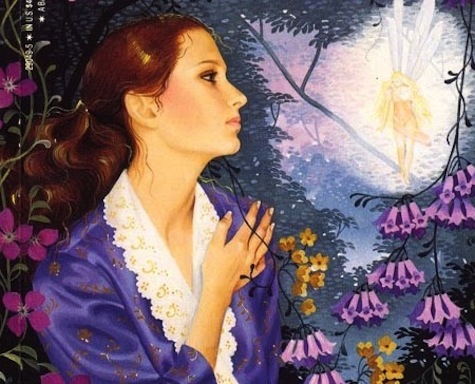When the powers that be here asked me to write a post about my feelings on “Celtic Fantasy,” my “yes” was a hesitant thing, dubious and hedged around with caveats. I can talk—a little—about intensely local Irish fantasy: Ian McDonald’s King of Morning, Queen of Day, or Ruth Frances Long’s A Crack in Everything. Or Jo Walton’s Táin-influenced The Prize in the Game, for that matter. (Or Kevin Barry’s City of Bohane, which is really fantasy set in the future, if you ask me.) Pat O’Shea’s The Hounds of the Morrigan and Michael Scott’s unfinished De Danann series were foundational texts for me before I turned ten: episodes from the Rúraíocht, especially the Táin Bó Cuailgne, and from the Fiannaíocht, cropped up in my primary school readers.
Some of the very first history I was formally taught involved the Christianisation of Ireland and the exploits of St. Patrick as taken from his Confession and a couple of 7th-century hagiographies. My secondary school English and History classes were practically swathed about in the “Celtic Twilight” and the late 19th/early 20th century Anglo-Irish literary renaissance:
“The host is riding from Knocknarea
And over the grave of Clooth-na-bare;
Caolte tossing his burning hair
And Niamh calling Away, come away—”(W.B. Yeats, “The Hosting of the Sidhe”)
But Celtic fantasy? What does that even mean, in this context?
Among scholars of pre-history, there is no general agreement—outside linguistics, where the use of the term “Celtic” for several language groups descended from Indo-European is no more or less arbitrary than the use of the term “Germanic” or “Semitic”—as to what “Celtic” means in terms of material culture; the 19th century theory that Hallstatt and La Tene material constitute definitively “Celtic” cultural assemblages is… fuzzy, let’s say. The surviving Celtic language groups (Goidelic, comprising Irish, Scots Gaelic, and Manx; and Brythonic, comprising Welsh, Cornish, and the Breton language) were spoken into the medieval period in a geographically limited range of locations which shared some cultural similarities beyond mere language kinship, so I guess “Celtic” is a thing we can point to and say more like that than the other thing. But the boundaries are fluid, and fuzzy, and edge cases are hard to pin down.
But Celtic fantasy?
Oh, Marion Zimmer Bradley, you did us all a disservice with Mists of Avalon. That’s a personal opinion, mind. I can’t stand that book.
According to the internet (because it should know, right?) “Celtic fantasy” comes in two main flavours: urban fantasy featuring beings from “Celtic” folktales, usually set in America, like Holly Black’s Tithe, or Seanan McGuire’s Toby Daye series, or Kevin Hearne’s Hounded and its sequels; or novels involving the Matter of Britain, like Bradley’s Mists of Avalon, or more recently Mercedes Lackey’s Gwenhwyfar: the White Spirit. There are outliers, like the novels of Juliet Marillier and Manda Scott’s Boudicca books (great story if you realise they’re taking place in a fantasy land with very little actual connection to real Roman Britain), but on the whole, that seems to be the general topography of the fictional landscape. Although there also appear to be people who consider Diana Gabaldon’s Outlander as “Celtic fantasy.”
(For those interested in such things, Kari Sperring has a very entertaining essay about some of the myths about “Celtic” history that crop up in fiction. I recommend it.)
Maybe it’s because of who I am and where I come from, but I don’t get the attraction of “Celtic” fantasy. It always seems strangely flat, compared to the complicated tangle that is Irish history: pieces of folklore taken out of context and seen through a distorted mirror that robs them of their local natures and their complexities.
My response to “Celtic fantasy” is tied up in a difficult knot connected to negotiating my own identity as Irish, and how I find space for myself in my own country and its history of language erasure and suppression of difference and layers of colonisation. In the myths it tells about itself and the faultlines it tries to paper over and never, quite, forgets. Celtic fantasy as a genre feature is a creation of expatriates and foreigners: it simplifies and romanticises, the dulled edge of a knife that never cuts the ones who produce it because they’re not close enough to bleed.
“I suppose that having to live
Among men whose rages
Are for small wet hills full of stones
When one man buys a patch and pays a high price for it
That is not the end of his paying.”(Patrick Kavanagh, “Having to Live in the Country”)
Bleed? Perhaps I exaggerate. There’s no real harm in it, after all. But the only novel I’ve ever read that does fantasy in a Irish world I recognise is Ian McDonald’s King of Morning, Queen of Day. A brilliant, powerful novel: and it works so well because it’s not Celtic, it doesn’t deal in generalities or a grab-bag of decontextualised folktales and pseudo-historical images. It works so well because it’s specific, and local, and rooted. And because it uses myth and fiction to have a—quite frankly terrifyingly—honest discussion of what modern Ireland means to (some of) its inhabitants.
That terrifying honesty, that rootedness, is what’s missing, for me, in most “Celtic fantasy.” So if you spot any going? Please let me know.
Liz Bourke is a cranky person who reads books. Her blog. Her Twitter.










